Use of Seashell and Limestone Fillers in Metakaolin-Based Geopolymers for Masonry Mortars
Abstract
:1. Introduction
2. Context and Scope of Paper
3. Experimental Program
3.1. Materials
3.2. Binder Proportions and Liquid Solutions
3.2.1. MC Binders
3.2.2. GP Binders
3.3. Testing Methods and Procedures
4. Results and Discussion
4.1. Repeatability of Test Responses
4.2. Tests on Pastes: Normal Consistency and Setting Times
4.3. Tests on Mortars
4.3.1. Water Demand
4.3.2. Air Content and Density
4.3.3. Water Retention
4.3.4. Compressive and Flexural Strengths
4.3.5. Pull-Off Strength
4.3.6. Sorptivity
5. Conclusions
- Because of increased hardness, the energy required for grinding the seashell into fine powder is remarkably higher than what is needed for the comminution of clinker or limestone materials. Although this may be sustainably inefficient, the superior mechanical properties conferred by the seashell additions were found to offset the higher energy demand needed for their grinding.
- The water demand decreased for MC binders containing increased filler (i.e., LF or seashell) content, which can be attributed to refinement in the binder packing density that reduces the need of water for proper lubrication. The longest setting times occurred for the MC5-LF mixture, given the inert nature of the limestone material that retards the initiation of cement hydration.
- The alkaline liquid solution necessary to achieve normal consistency for GP binders almost tripled when compared to the water demand required for MC binders. This was attributed to the viscous nature of the alkaline solution that increases the cohesiveness of the interstitial liquid phase and hinders the ease of flowability.
- The replacement of limestone by seashell did not alter the setting times, whether for the cement-based or MK-based mixtures. This physically implies that such materials do not interfere with the hydration or geopolymerization reactions including the development of reacted compounds at early ages after mixing.
- The air content for tested MC and GP mortars was in compliance with the EN 413-1 and ASTM C91 requirements. Yet, the density of MC mixtures was slightly higher than the one recorded using GP mortars, which can be attributed to different specific gravities of the cement and metakaolin materials.
- The water retention for all GP mortars reached 100%, regardless of the limestone or seashell additions. This was directly related to the viscous nature of the liquid alkaline solution that increases the mixture stickiness and resistance to water loss under the vacuuming pressure.
- Just like the cement-based mortars, the mechanical properties of GP mixtures including the compressive strength, flexural strength, pull-off bond, and water sorptivity decreased when the seashell or limestone concentration increased in the mixture. This was mainly related to a dilution effect that reduces the aluminosilicate precursor (or cement) content, thus reducing the formation of rigid bonds.
- The effect of replacing limestone by seashell powder slightly increased the compressive, flexural, and pull-off bond strengths. For almost similar Blaine fineness, the strength improvement can be attributed to increased material hardness that densifies the microstructure and provides additional resistance to support the external loading.
- The GPs do not require continuous wet curing to develop their strengths under ambient temperatures. This can be relevant for masonry works to accelerate the placement operations without the need to moist cure the plastering surfaces several times during the day.
Author Contributions
Funding
Data Availability Statement
Conflicts of Interest
References
- Aïtcin, P.C. Supplementary cementitious materials and blended cements. In Science and Technology of Concrete Admixtures; Elsevier: Amsterdam, The Netherlands, 2016. [Google Scholar] [CrossRef]
- Assaad, J.J. Quantifying the effect of clinker grinding aids under laboratory conditions. Miner. Eng. 2015, 81, 40–51. [Google Scholar] [CrossRef]
- Mehta, P.K.; Monteiro, P.J.M. Concreto: Microestrutura, Propriedades e Materiais, 2nd ed.; Ibracon: São Paulo, Brazil, 2014; pp. 594–602. [Google Scholar]
- Bamigboye, G.O.; Nworgu, A.T.; Odetoyan, A.O.; Kareem, M.; Enabulele, D.O.; Bassey, D.E. Sustainable use of seashells as binder in concrete production: Prospect and challenges. J. Build. Eng. 2021, 34, 101864. [Google Scholar] [CrossRef]
- Wang, J.; Liu, E.; Li, L. Characterization on the recycling of waste seashells with Portland cement towards sustainable cementitious materials. J. Clean. Prod. 2019, 220, 235–252. [Google Scholar] [CrossRef]
- Aris, S.M.; Muthusamy, K.; Uzer, A.; Ahmad, S.W. Properties of palm oil fuel ash cement sand brick containing pulverized cockle shell as partial sand replacement. IOP Conf. Ser. Earth Environ. Sci. 2018, 140, 012145. [Google Scholar] [CrossRef]
- Lakshmi, S.M.; Geetha, S.; Selvakumar, M.; Mahalakshmi, S.; Pavithra, A. Effective usage of seashell waste to improve the strength characteristics of silty sand. Mater. Today Proc. 2022, 65, 484–488. [Google Scholar] [CrossRef]
- Eziefula, U.G.; Ezeh, J.C.; Eziefula, B.I. Properties of seashell aggregate concrete: A review. Constr. Build. Mater. 2018, 192, 287–300. [Google Scholar] [CrossRef]
- Sangeetha, P.; Shanmugapriya, M.; Saravanan, K.S.; Prabhakaran, P.; Shashankar, V. Mechanical properties of concrete with seashell waste as partial replacement of cement and aggregate. Mater. Today Proc. 2022, 61, 320–326. [Google Scholar] [CrossRef]
- Martínez-García, C.; González-Fonteboa, B.; Martínez-Abella, F.; López, D.C. Performance of mussel shell as aggregate in plain concrete. Constr. Build. Mater. 2017, 139, 570–583. [Google Scholar] [CrossRef]
- de Alvarenga, R.A.F.; Galindro, B.M.; de Fátima Helpa, C.; Soares, S.R. The recycling of oyster shells: An environmental analysis using Life Cycle Assessment. J. Environ. Manag. 2012, 106, 102–109. [Google Scholar] [CrossRef] [PubMed]
- Lertwattanaruk, P.; Makul, N.; Siripattarapravat, C. Utilization of ground waste seashells in cement mortars for masonry and plastering. J. Environ. Manag. 2012, 111, 133–141. [Google Scholar] [CrossRef]
- Cuadrado-Rica, H.; Sebaibi, N.; Boutouil, M.; Boudart, B. Properties of ordinary concretes incorporating crushed queen scallop shells. Mater. Struct. 2016, 49, 1805–1816. [Google Scholar] [CrossRef]
- Othman, N.H.; Bakar, B.H.A.; Don, M.M.; Johari, M.A.M. Cockle shell ash replacement for cement and filler in concrete. Malays. J. Civ. Eng. 2013, 1–25. [Google Scholar]
- Mobili, A.; Belli, A.; Telesca, A.; Marroccoli, M.; Tittarelli, F. Calcium Sulfoaluminate and Geopolymeric Binders as Alternatives to OPC. In Durability and Sustainability of Concrete Structures, SP-326; Falikman, V., Realfonzo, R., Coppola, L., Hàjek, P., Riva, P., Eds.; American Concrete Institute: Farmington Hills, MI, USA, 2018; pp. 28.1–28.10. [Google Scholar]
- Lu, X.; Liu, B.; Zhang, Q.; Wen, Q.; Wang, S.; Xiao, K.; Zhang, S. Recycling of Coal Fly Ash in Building Materials: A Review. Minerals 2023, 13, 25. [Google Scholar] [CrossRef]
- Rakhimova, N.; Rakhimov, R. Reaction products, structure and properties of alkali-activated metakaolin cements incorporated with supplementary materials—A review. J. Mater. Res. Technol. 2019, 8, 1522–1531. [Google Scholar] [CrossRef]
- Ji, X.; Gu, X.; Wang, Z.; Xu, S.; Jiang, H.; Yilmaz, E. Admixture Effects on the Rheological/Mechanical Behavior and Micro-Structure Evolution of Alkali-Activated Slag Backfills. Minerals 2023, 13, 30. [Google Scholar] [CrossRef]
- Hwalla, J.; Saba, M.; Assaad, J.J. Suitability of metakaolin-based geopolymers for underwater applications. Mater. Struct. 2020, 53, 119. [Google Scholar] [CrossRef]
- Chen, L.; Wang, Z.; Wang, Y.; Feng, J. Preparation and Properties of Alkali Activated Metakaolin-Based Geopolymer. Materials 2016, 9, 767. [Google Scholar] [CrossRef] [PubMed] [Green Version]
- De Silva, P.; Sagoe-Crenstil, K.; Sirivivatnanon, V. Kinetics of geopolymerization: Role of Al2O3 and SiO2. Cem. Concr. Res. 2007, 37, 512–518. [Google Scholar] [CrossRef]
- Saba, M.; Assaad, J.J. Effect of recycled fine aggregates on performance of geopolymer masonry mortars. Constr. Build. Mater. 2021, 279, 122461. [Google Scholar] [CrossRef]
- AlArab, A.; Hamad, B.; Assaad, J.J. Strength and Durability of Concrete Containing Ceramic Waste Powder and Blast Furnace Slag. J. Mater. Civ. Eng. 2022, 34, 04021392. [Google Scholar] [CrossRef]
- Perez-Cortes, P.; Escalante-Garcia, J.I. Design and optimization of alkaline binders of limestone-metakaolin—A comparison of strength, microstructure and sustainability with portland cement and geopolymers. J. Clean. Prod. 2020, 273, 123118. [Google Scholar] [CrossRef]
- Wang, D.; Shi, C.; Farzadnia, N.; Shi, Z.; Jia, H. A review on effects of limestone powder on the properties of concrete. Constr. Build. Mater. 2018, 192, 153–166. [Google Scholar] [CrossRef]
- Cwirzen, A.; Provis, J.L.; Penttala, V.; Habermehl-Cwirzen, K. The effect of limestone on sodium hydroxide-activated metakaolin-based geopolymers. Constr. Build. Mater. 2014, 66, 53–62. [Google Scholar] [CrossRef]
- Qian, J.; Song, M. Study on influence of limestone powder on the fresh and hardened properties of early age metakaolin based geopolymer. In Proceedings of the 1st International Conference on Calcined Clays for Sustainable Concrete; Springer: Dordrecht, The Netherlands, 2015; pp. 235–259. [Google Scholar]
- Rovnaník, P. Effect of curing temperature on the development of hard structure of metakaolin-based geopolymer. Constr. Build. Mater. 2010, 24, 1176–1183. [Google Scholar] [CrossRef]
- Kuenzel, C.; Vandeperre, L.J.; Donatello, S.; Boccaccini, A.R.; Cheeseman, C. Ambient Temperature Drying Shrinkage and Cracking in Metakaolin-Based Geopolymers. J. Am. Ceram. Soc. 2012, 95, 3270–3277. [Google Scholar] [CrossRef] [Green Version]
- Shekhovtsova, J.; Kovtun, M.; Kearsley, E.P. Temperature rise and initial shrinkage of alkali-activated fly ash cement pastes. Adv. Cem. Res. 2015, 28, 3–12. [Google Scholar] [CrossRef] [Green Version]
- ACI 524R-16; Guide to Portland Cement-Based Plaster. American Concrete Institute: Farmington Hills, MI, USA, 2016; p. 40.
- ASTM C270-19ae1; Standard Specification for Mortar for Unit Masonry. ASTM International: West Conshohocken, PA, USA, 2019.
- Silva, R.; de Brito, J.; Dhir, R. Performance of cementitious renderings and masonry mortars containing recycled aggregates from construction and demolition wastes. Constr. Build. Mater. 2016, 105, 400–415. [Google Scholar] [CrossRef]
- Assaad, J.J.; Vachon, M. Valorizing the use of recycled fine aggregates in masonry cement production. Constr. Build. Mater. 2021, 310, 125263. [Google Scholar] [CrossRef]
- Valluzzi, M.R. On the vulnerability of historical masonry structures: Analysis and mitigation. Mater. Struct. 2007, 40, 723–743. [Google Scholar] [CrossRef]
- Zhao, X.; Zhao, L.; Yang, Q.; Wang, Z.; Cheng, A.; Mo, L.; Yan, J. Permeability and Disintegration Characteristics of Composite Improved Phyllite Soil by Red Clay and Cement. Minerals 2023, 13, 32. [Google Scholar] [CrossRef]
- Assaad, J.J. Development of polymer-modified cement for adhesive and repair applications. Constr. Build. Mater. 2018, 163, 139–148. [Google Scholar] [CrossRef]
- Vegas, I.; Azkarate, I.; Juarrero, A.; Frias, M. Design and performance of masonry mortars made with recycled concrete aggregates. Mater. De Construcción 2009, 59, 5–18. [Google Scholar] [CrossRef] [Green Version]
- EN 413-1; Masonry Cement–Part 1: Composition, Specifications, and Conformity Criteria. Comite Europeen de Normalisation: Brussels, Belgium, 2011.
- ASTM C91/C91M-18; Standard Specification for Masonry Cement. ASTM International: West Conshohocken, PA, USA, 2018.
- Assaad, J.J. Effect of energy and temperature on performance of alkanolamine processing additions. Miner. Eng. 2017, 102, 30–41. [Google Scholar] [CrossRef]
- ASTM C204-18e1; Standard Test Methods for Fineness of Hydraulic Cement by Air-Permeability. ASTM International: West Conshohocken, PA, USA, 2018.
- ASTM C188-17; Standard Test Method for Density of Hydraulic Cement. ASTM International: West Conshohocken, PA, USA, 2017.
- ASTM C187-16; Standard Test Method for Amount of Water Required for Normal Consistency of Hydraulic Cement Paste. ASTM International: West Conshohocken, PA, USA, 2016.
- ASTM C266-18; Standard Test Method for Time of Setting of Hydraulic-Cement Paste by Gillmore Needles. ASTM International: West Conshohocken, PA, USA, 2018.
- ASTM C231/C231M-17a; Standard Test Method for Air Content of Freshly Mixed Concrete by the Pressure Method. ASTM International: West Conshohocken, PA, USA, 2017.
- ASTM C1506-17; Standard Test Method for Water Retention of Hydraulic Cement-Based Mortars and Plasters. ASTM International: West Conshohocken, PA, USA, 2017.
- BS EN 196-1; Methods of Testing Cement. Determination of Strength. Comite Europeen de Normalisation: Brussels, Belgium, 2016.
- BS EN 1542; Products and Systems for the Protection and Repair of Concrete Structures. Test Methods. Measurement of Bond Strength by Pull-Off. Comite Europeen de Normalisation: Brussels, Belgium, 1999.
- Assaad, J.J.; Issa, C.A. Effect of Recycled Acrylic-Based Polymers on Bond Stress-Slip Behavior in Reinforced Concrete Structures. J. Mater. Civ. Eng. 2017, 29, 04016173. [Google Scholar] [CrossRef]
- ASTM C1585-13; Standard Test Method for Measurement of Rate of Absorption of Water by Hydraulic-Cement Concretes. ASTM International: West Conshohocken, PA, USA, 2013.
- Palacios, M.; Banfill, P.F.G.; Puertas, F. Rheology and setting of alkali-activated slag pastes and mortars: Effect of organic admixture. Mater. J. 2008, 105, 140–148. [Google Scholar]
- Favier, A.; Hot, J.; Habert, G.; Roussel, N.; d’Espinose de Lacaillerie, J.-B. Flow properties of MK-based geopolymer pastes. A comparative study with standard Portland cement pastes. Soft Matter 2014, 10, 1134–1141. [Google Scholar] [CrossRef]
- Palomo, A.; Banfill, P.F.G.; Fernández-Jiménez, A.; Swift, D.S. Properties of alkali-activated fly ashes determined from rheological measurements. Adv. Cem. Res. 2015, 17, 143–151. [Google Scholar] [CrossRef]

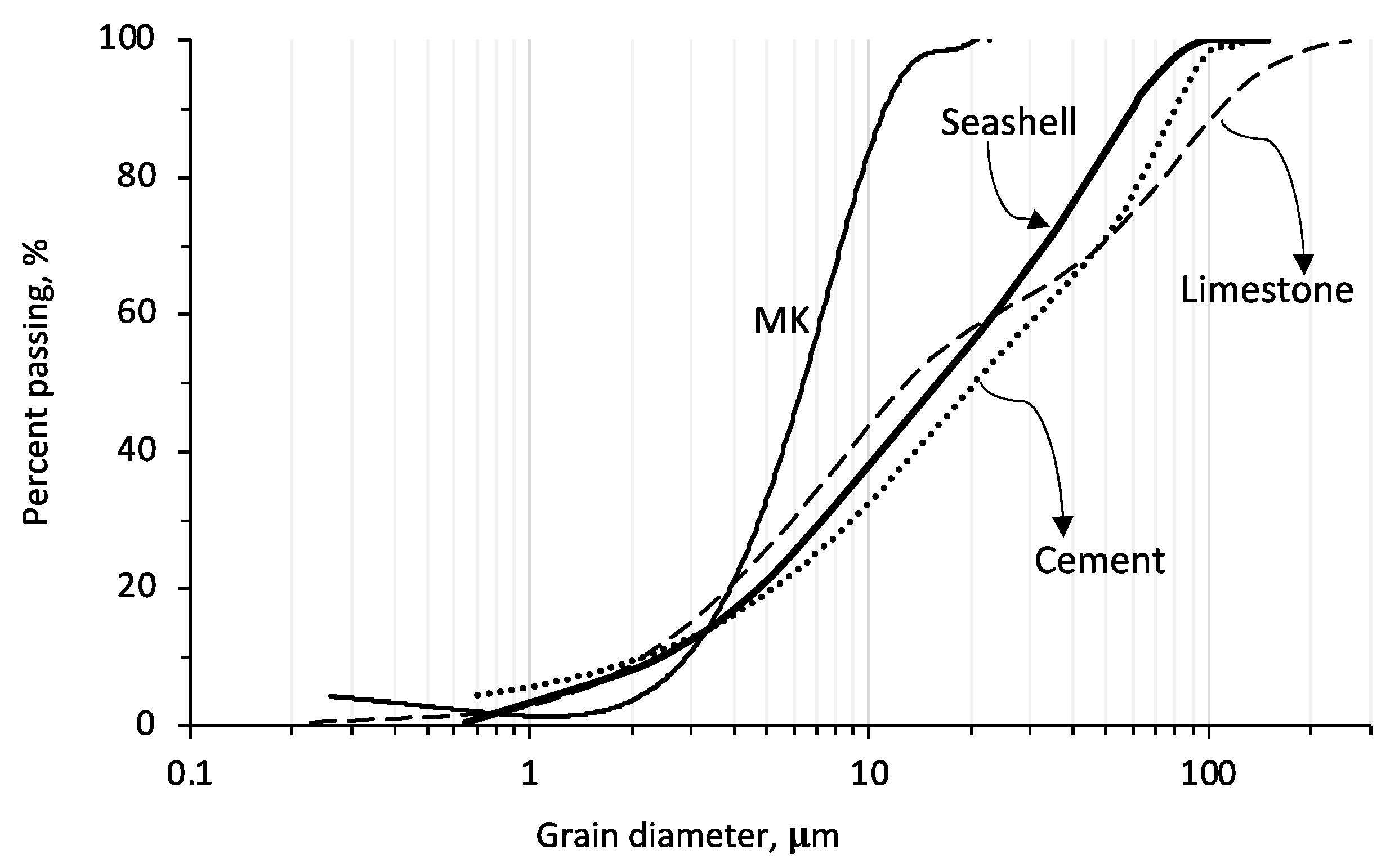
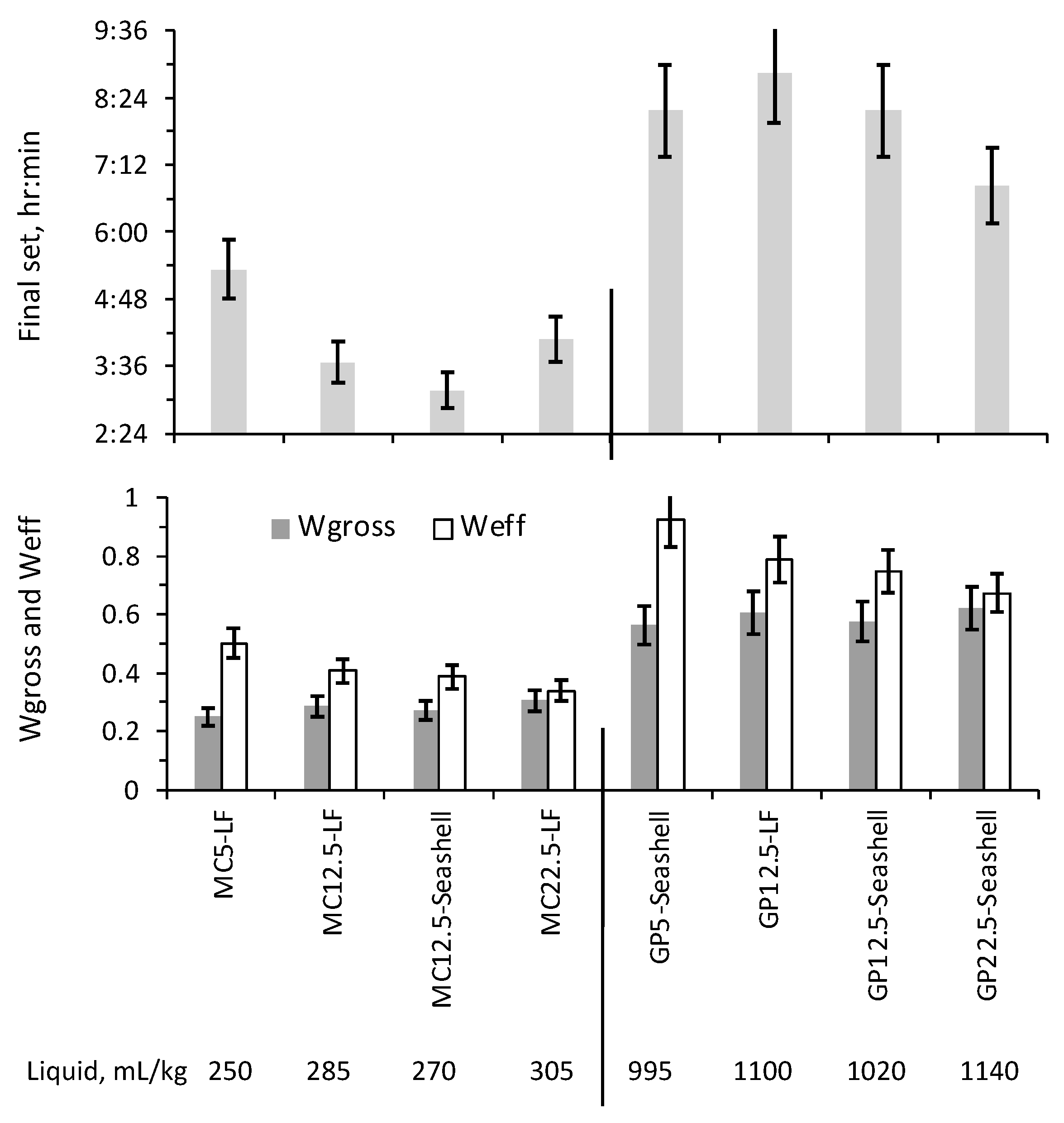
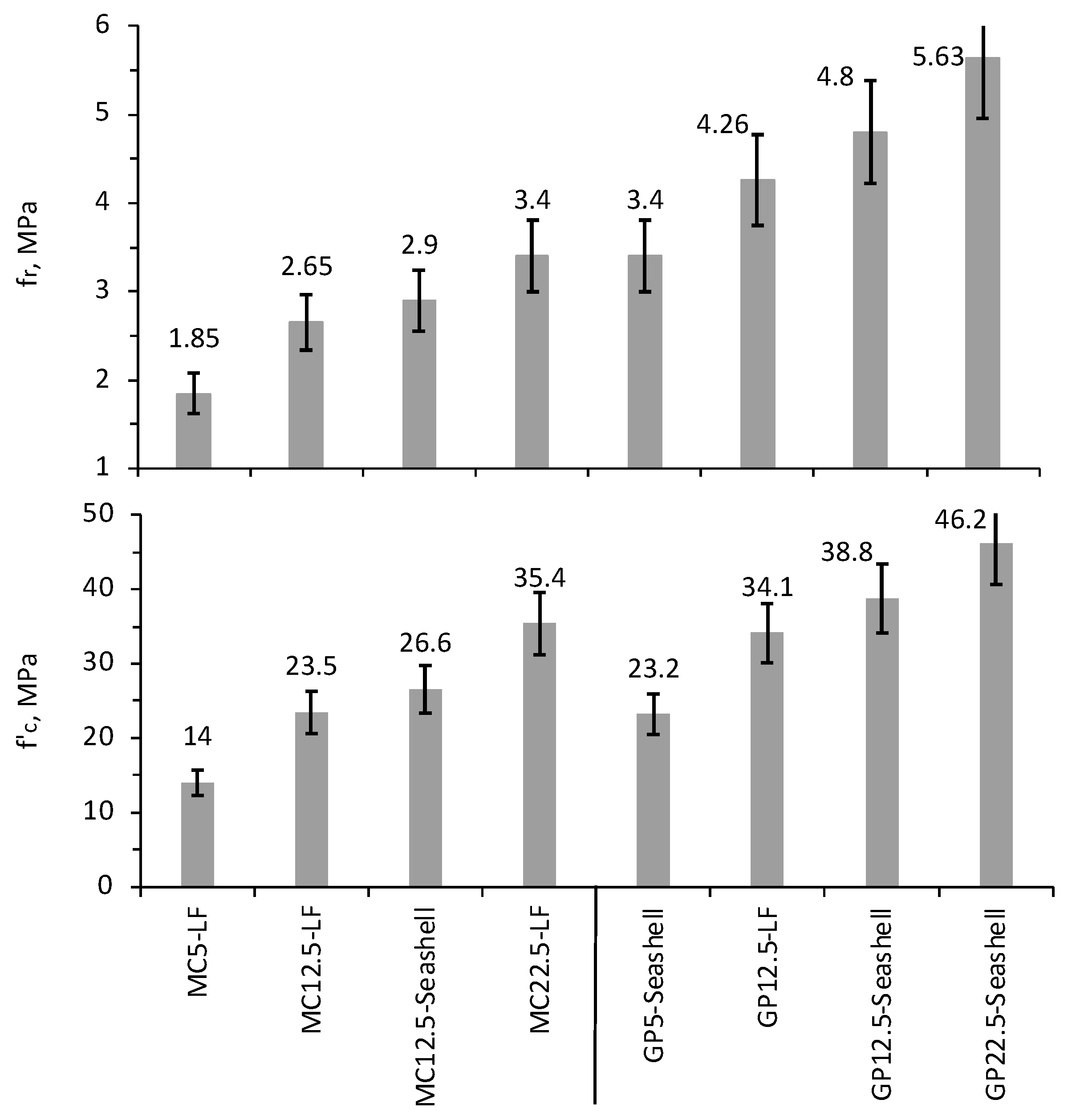

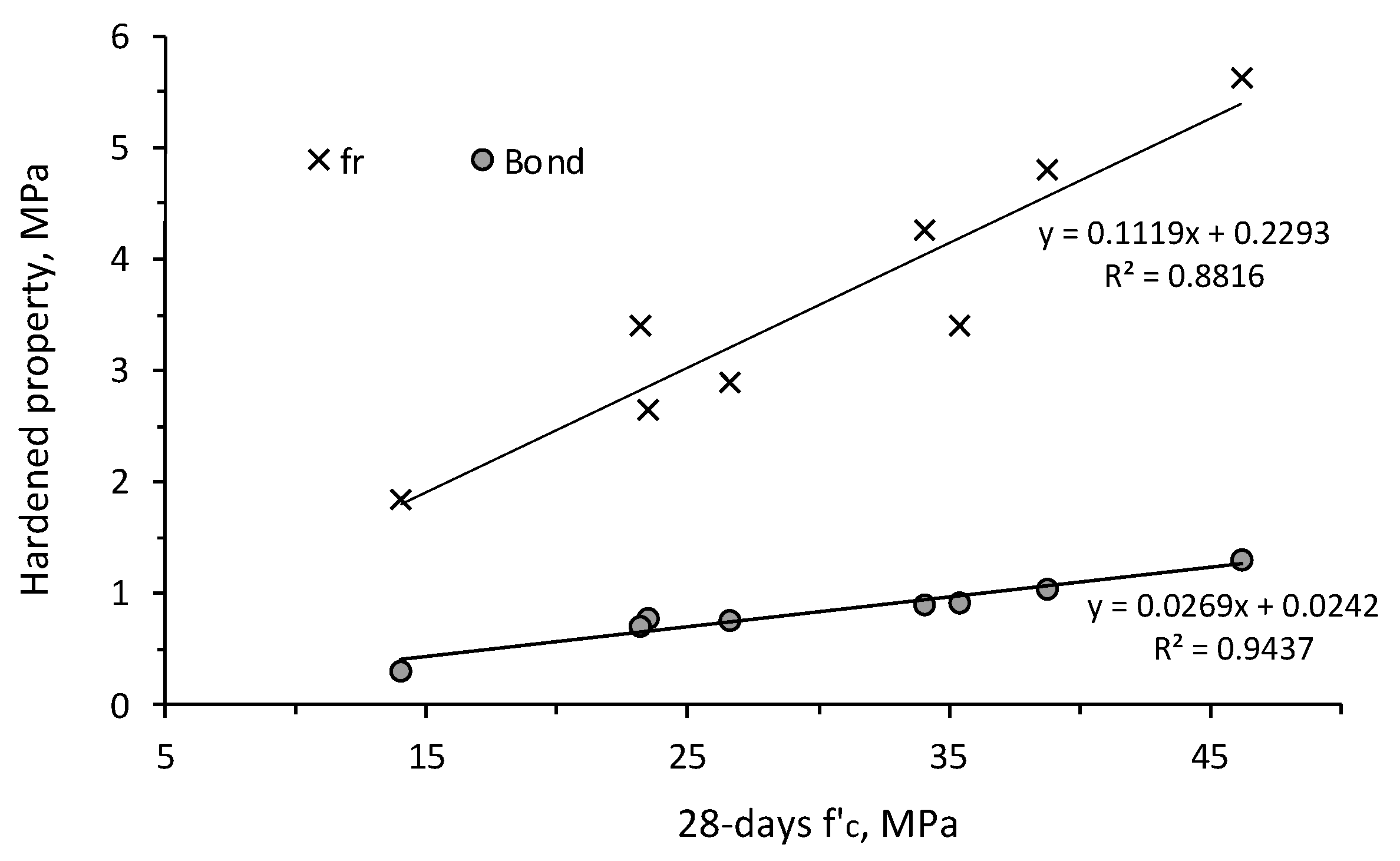
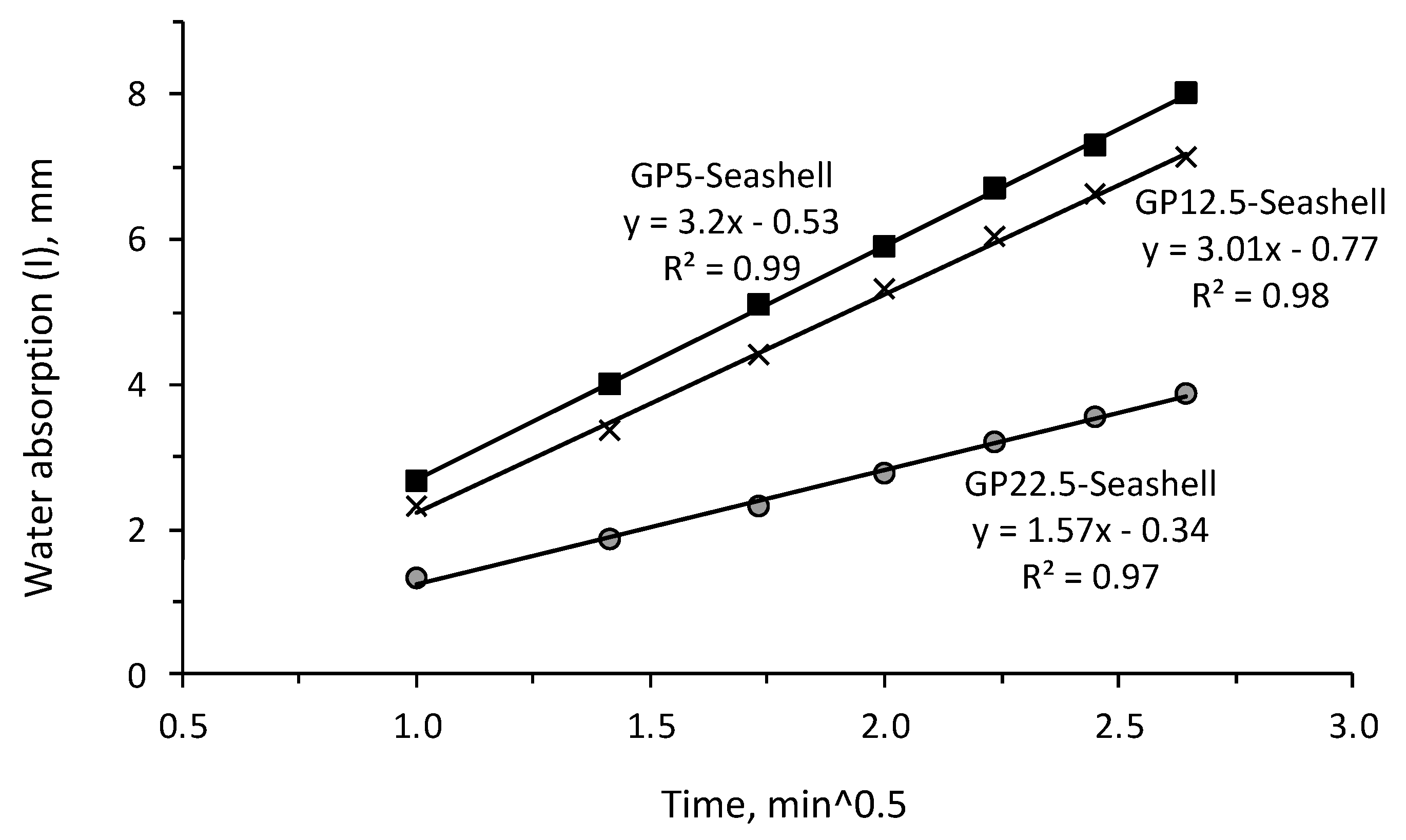
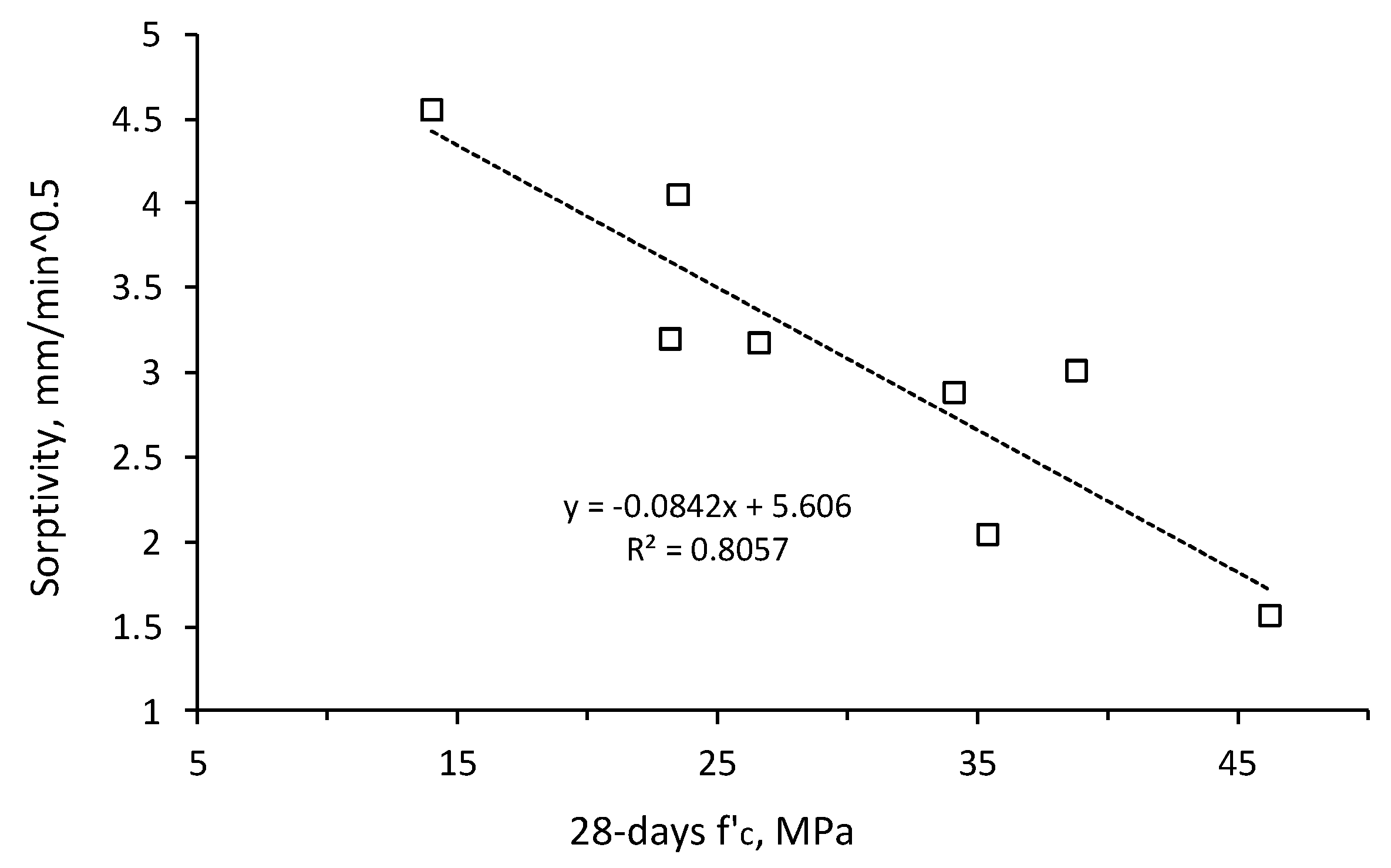
| Cement | LF | MK | Seashell | |
|---|---|---|---|---|
| SiO2, % | 21.4 | 5.74 | 55 | 2.27 |
| Al2O3, % | 4.3 | 0.15 | 39 | 0.84 |
| Fe2O3, % | 3.1 | 0.05 | 1.8 | 0.22 |
| CaO, % | 62.9 | 48.8 | 0.35 | 53.7 |
| MgO, % | 2.8 | 0.08 | 0.25 | - |
| SO3, % | 0.45 | 1.33 | - | - |
| Na2Oeq., % | 0.52 | - | - | 0.18 |
| TiO2, % | - | - | 1.5 | - |
| 28-day compression, MPa | 45.5 | - | - | - |
| Blaine specific surface, m2/kg | 335 | 360 | - | 345 |
| Surface area B.E.T., m2/kg | - | - | 19,000 | - |
| Specific gravity | 3.15 | 2.68 | 2.2 | 2.82 |
| Loss on ignition, % | 1.85 | 41.7 | 1 | - |
| Liquid Demand, mL/kg | wgross | weff | Initial Set Time, Min | Final Set Time, Min | |
|---|---|---|---|---|---|
| MC5-LF | 250 | 0.25 | 0.5 | 210 | 320 |
| MC12.5-LF | 285 | 0.285 | 0.407 | 145 | 220 |
| MC12.5-Seashell | 270 | 0.27 | 0.386 | 140 | 190 |
| MC22.5-LF | 305 | 0.305 | 0.339 | 160 | 245 |
| GP5-Seashell | 995 | 0.563 | 0.925 | 410 | 490 |
| GP12.5-LF | 1100 | 0.606 | 0.787 | 405 | 530 |
| GP12.5-Seashell | 1020 | 0.574 | 0.748 | 420 | 490 |
| GP22.5-Seashell | 1140 | 0.622 | 0.674 | 390 | 410 |
| MC5-LF | MC12.5-LF | MC12.5-Seashell | MC22.5-LF | |
|---|---|---|---|---|
| Liquid demand, mL/kg | 258 | 264 | 250 | 290 |
| wgross | 1.147 | 0.838 | 0.794 | 0.716 |
| weff | 0.573 | 0.587 | 0.556 | 0.644 |
| Air content, % | 12 | 10 | 13 | 12 |
| Density, kg/m3 | 1920 | 1890 | 1925 | 1940 |
| Water retention, % | 88 | 86 | 81 | 74 |
| 7 d , MPa | 8.2 | 17.3 | 20.1 | 27.6 |
| 28 d , MPa | 14 | 23.5 | 26.6 | 35.4 |
| 28 d , MPa | 1.85 | 2.65 | 2.9 | 3.4 |
| Pull-off bond, MPa | 0.31 | 0.77 | 0.76 | 0.92 |
| Sorptivity, mm/min0.5 | 4.55 | 4.05 | 3.18 | 2.04 |
| GP5-Seashell | GP12.5-LF | GP12.5-Seashell | GP22.5-Seashell | |
|---|---|---|---|---|
| Liquid demand, mL/kg | 320 | 370 | 345 | 395 |
| wgross | 1.084 | 0.967 | 0.923 | 0.797 |
| weff | 0.685 | 0.762 | 0.723 | 0.856 |
| Air content, % | 9 | 13 | 12 | 13 |
| Density, kg/m3 | 1890 | 1860 | 1900 | 1910 |
| Water retention, % | 100 | 100 | 100 | 100 |
| 7 d , MPa | 18.7 | 32.1 | 34 | 38.3 |
| 28 d , MPa | 23.2 | 34.1 | 38.8 | 46.2 |
| 28 d , MPa | 3.4 | 4.26 | 4.8 | 5.63 |
| Pull-off bond, MPa | 0.71 | 0.9 | 1.04 | 1.3 |
| Sorptivity, mm/min0.5 | 3.2 | 2.88 | 3.01 | 1.57 |
Disclaimer/Publisher’s Note: The statements, opinions and data contained in all publications are solely those of the individual author(s) and contributor(s) and not of MDPI and/or the editor(s). MDPI and/or the editor(s) disclaim responsibility for any injury to people or property resulting from any ideas, methods, instructions or products referred to in the content. |
© 2023 by the authors. Licensee MDPI, Basel, Switzerland. This article is an open access article distributed under the terms and conditions of the Creative Commons Attribution (CC BY) license (https://creativecommons.org/licenses/by/4.0/).
Share and Cite
Assaad, J.J.; Saba, M. Use of Seashell and Limestone Fillers in Metakaolin-Based Geopolymers for Masonry Mortars. Minerals 2023, 13, 186. https://doi.org/10.3390/min13020186
Assaad JJ, Saba M. Use of Seashell and Limestone Fillers in Metakaolin-Based Geopolymers for Masonry Mortars. Minerals. 2023; 13(2):186. https://doi.org/10.3390/min13020186
Chicago/Turabian StyleAssaad, Joseph Jean, and Marianne Saba. 2023. "Use of Seashell and Limestone Fillers in Metakaolin-Based Geopolymers for Masonry Mortars" Minerals 13, no. 2: 186. https://doi.org/10.3390/min13020186





